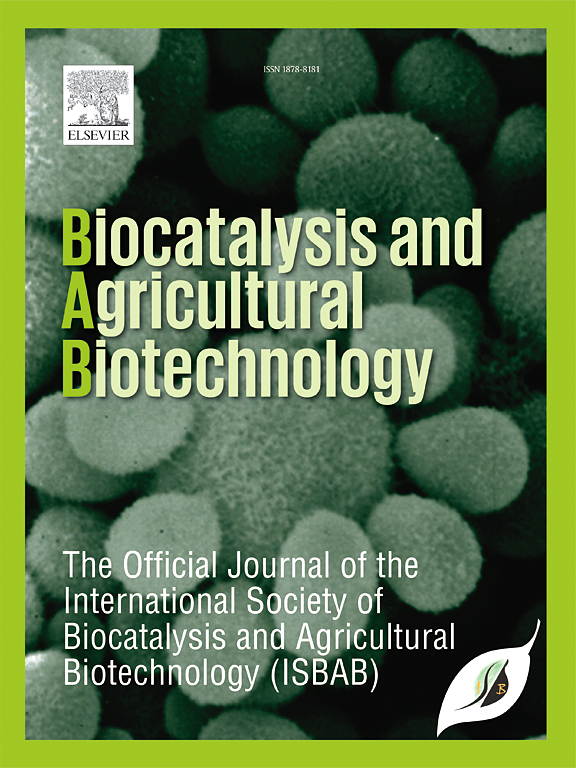微生物合成氧化锌纳米粒子及其作为抗菌剂和抗癌剂的潜在生物应用
IF 3.4
Q2 BIOTECHNOLOGY & APPLIED MICROBIOLOGY
引用次数: 0
摘要
纳米氧化锌粒子(ZnO-NPs)是一种金属氧化物纳米材料,因其独特的物理和化学性质,被公认为是一种有价值且适应性强的无机化合物。纳米氧化锌微粒因其微小的尺寸而具有强大的抗菌性能,可激活细菌细胞内的各种杀菌机制,包括与细菌表面或核心相互作用、产生活性氧(ROS)、释放 Zn2+ 以及细胞潜在的内吞作用。利用 PP6 菌株的色素提取物在细胞外产生了 ZnO NPs 纳米颗粒。琼脂井筛选表明 PP6 次级代谢产物具有抗菌特性。紫外可见光谱用于分析纳米粒子的外部生长情况。扫描电子显微镜(SEM)、傅立叶变换红外光谱(FTIR)和 X 射线衍射(XRD)技术用于分析 PP6 ZnO NPs 菌株的形状、稳定性、晶体结构和涂层。PP6 ZnO NPs 对所测试的细菌病原体具有抗生物膜影响,这种影响取决于用量。脂质过氧化物(LPO)水平升高和抗氧化活性降低是癌细胞凋亡的标志。通过对 HT-29 人结肠直肠腺癌细胞进行 MTT 试验,评估了合成的氧化锌纳米粒子的抗癌特性。暴露于 HT-29 细胞中的 ZnO NPs 纳米粒子的存活率随着纳米粒子浓度的增加而显著降低。要全面了解其作用机制,还需要进行更多的综合研究。本文章由计算机程序翻译,如有差异,请以英文原文为准。
Microbial synthesis of zinc oxide nanoparticles and their potential biological application as an antimicrobial and anticancer agent
Zinc oxide nanoparticles (ZnO-NPs) are a type of metal oxide nanomaterial, recognized as a valuable and adaptable inorganic compound owing to its distinctive physical and chemical properties. Nanosized ZnO particles exhibit substantial antibacterial properties attributable to their diminutive size, which can activate various bactericidal mechanisms within the bacterial cell, including interactions with the bacterial surface or core, the generation of reactive oxygen species (ROS), the release of Zn2+, and potential endocytosis by cells. ZnO NPs nanoparticles were extracellularly produced using pigment extracts from the PP6 strain. Agar well screening indicated that PP6 secondary metabolites possess antibacterial properties. UV–Vis spectroscopy was used to analyze the external growth of nanoparticles. Scanning Electron Microcopy (SEM), Fourier Transform Infrared Spectroscopy (FTIR), and X-ray diffraction (XRD) techniques were employed to analyze the shape, stability, crystalline structure, and coating of strain PP6 ZnO NPs. The PP6 ZnO NPs demonstrated an antibiofilm impact on the bacterial pathogens tested, which was dependent on the dosage. Elevated levels of lipid peroxidation (LPO) and reduced antioxidant activity are indicative of apoptosis in cancer cells. The synthesized ZnO NPs nanoparticles were assessed for their anticancer properties by performing the MTT assay on HT-29 human colorectal adenocarcinoma cells. ZnO NPs nanoparticles exposed to HT-29 cells the viability was reduced significantly in proportion to the concentration of nanoparticles. Additional comprehensive study will be needed to fully understand their mechanism.
求助全文
通过发布文献求助,成功后即可免费获取论文全文。
去求助
来源期刊

Biocatalysis and agricultural biotechnology
Agricultural and Biological Sciences-Agronomy and Crop Science
CiteScore
7.70
自引率
2.50%
发文量
308
审稿时长
48 days
期刊介绍:
Biocatalysis and Agricultural Biotechnology is the official journal of the International Society of Biocatalysis and Agricultural Biotechnology (ISBAB). The journal publishes high quality articles especially in the science and technology of biocatalysis, bioprocesses, agricultural biotechnology, biomedical biotechnology, and, if appropriate, from other related areas of biotechnology. The journal will publish peer-reviewed basic and applied research papers, authoritative reviews, and feature articles. The scope of the journal encompasses the research, industrial, and commercial aspects of biotechnology, including the areas of: biocatalysis; bioprocesses; food and agriculture; genetic engineering; molecular biology; healthcare and pharmaceuticals; biofuels; genomics; nanotechnology; environment and biodiversity; and bioremediation.
 求助内容:
求助内容: 应助结果提醒方式:
应助结果提醒方式:


